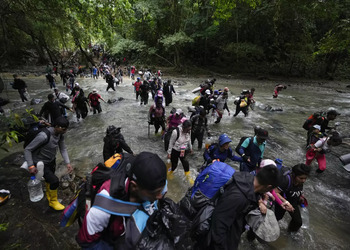A recent report has underlined the perilous situation faced by thousands of migrants as they cross the Darién Gap, one of the most dangerous migration routes in the world, now under the control of a Colombian criminal group.
The report, published by Human Rights Watch (HRW), describes the experiences of migrants crossing the Darién Gap, a dense and mountainous jungle region on the border between Colombia and Panama. The majority of these migrants are traveling to the United States, and according to the report, they are exposed to violence from criminal groups at every stage along their journey.
Nearly 440,000 Venezuelans, 80,000 Ecuadorians, and 63,000 Haitians fleeing political, economic, and security crises crossed the Darién between January 2022 and November 2023, according to HRW.
The Gaitanistas, also known as the Gaitanist Self-Defense Forces of Colombia (Autodefensas Gaitanistas de Colombia – AGC), a ruthless criminal organization, dominate the Colombian side of the border. Meanwhile, the smaller criminal gangs that control the Panamanian side have subjected migrants to systematic violence and assaults.
InSight Crime outlines three of the report’s conclusions about the criminal groups operating along this route, as well as the state weaknesses that have made it possible for these groups to dominate the Darién Gap.
AGC: Law and Order on the Colombian Border
The AGC has long dominated drug trafficking along Colombia’s border with Panama.
Following the capture of the group’s leader, Dairo Antonio Úsuga, alias “Otoniel,” the AGC shed its hierarchical structure and divided into more independent cells. Some of those cells have increased their participation in other criminal economies, including human smuggling across the Darién.
The group carries out three main activities in the Darién Gap, according to Juan Pappier, the sub-director of the Americas Division of HRW.
First, the AGC regulates and administers migration routes. “It manages migration routes so they don’t conflict with its cocaine trafficking routes north, ensuring that migrants do not travel along the same paths,” Pappier told InSight Crime. “In practice, the Gaitanistas are the ones who permit migrants’ movements through the Darién,” he added.
In early 2023, migrants paid up to $440 for transportation from Necoclí, a municipality located on the Gulf of Urabá, to Carreto, a Panamanian town on the other side of the border. In other cases, migrants paid $310-350 just to travel from Necoclí to Acandí or Capurganá, two Colombian towns close to the border.
The AGC charges a tax of up to 20% from guides and communities who guide migrants through the Darién. Since the beginning of the year, prices have risen, so the AGC may be making a profit of nearly $125 per migrant crossing the border, according to Pappier. This would add up to estimated annual earnings of $57 million.
Second, the AGC uses migrant boats to divert the attention of maritime authorities and avoid seizures of their drug shipments.
“In some cases, boats departing from informal ports leave at the same time as boats smuggling cocaine, and when there is a naval operation, the AGC use the migrant boats. They send out the migrant boat first to distract [the authorities] from the cocaine-carrying boat, which they launch later,” explained Pappier.
Third, the AGC uses migrants as human couriers for small drug shipments, most commonly when the gang learns that an individual has tried to cross the border without paying a guide.
Panamanian Gangs Fill the Darién’s Power Vacuum
Migrants continue to face violence once they have crossed to the Panamanian side of the border. Several people told HRW that groups of eight to 15 armed men assaulted them immediately after they had crossed the border. The assailants stole money and sexually assaulted women.
There is little information available on these Panamanian groups.
“It appears that often, these are groups made up of locals, including Indigenous people, who are exploiting migrants,” said Pappier.
Near-total impunity and the lack of state presence on the Panamanian side of the Darién has allowed small criminal groups to form. So far, there is no evidence that they are linked to a larger criminal group, like the AGC.
Without a dominant Panamanian criminal actor, the AGC has an opportunity to expand into Panamanian territory. Local gangs could end up allying with the Colombian organization to increase their income.
There Is No Stopping Migration, but States Can Reduce Migrants’ Risks
On both sides of the border, gangs have faced a weak response from state authorities. Panama and Colombia have struggled to dismantle groups along the border, in part because of poor strategic planning, according to Pappier.
“There is no clear strategy to prosecute the AGC’s role in migrant smuggling. The area is not a high priority for the Colombian Attorney General’s Office,” he said.
This indifference is partially due to low indicators of violence in the region. According to data from the Colombian National Police (Policía Nacional de Colombia), only three homicides were reported in Acandí, a municipality on the border with Panama, between January and October 2023. There, the AGC has implemented strict social control to avoid security and intelligence officials’ attention.
Existing efforts against this transnational criminal economy are also hindered by limited cooperation between Colombia and Panama.
“As far as we know, Colombian-Panamanian cooperation has not achieved a single arrest,” said Pappier. “When we’re talking about such a porous border where it is so difficult to investigate, if there isn’t any cooperation between the two justice systems, it will be very difficult to make any headway in dismantling armed groups.”

